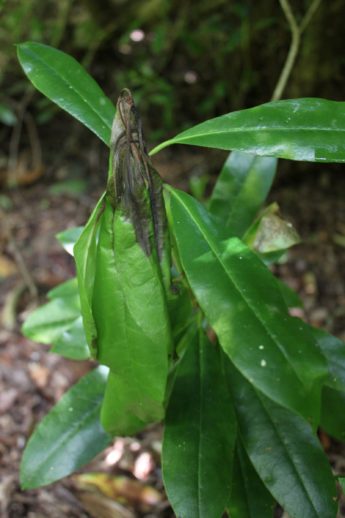An article for the Grampian Club bulletin by Dr David Cooke
Plant disease strikes at Inbhirfhaolain

It is uncommon for my work as a plant pathologist and my mountaineering to overlap but the moment I saw the dying Rhododendron in front of the club hut it was clear we had a problem. I am no lover of the invasive Rhododendron ponticum that chokes the understorey vegetation in so many Scottish woodlands so why was I not celebrating at the sight of a sickly one? The answer – because it was infected with a microbial pathogen called Phytophthora. That ‘phth’ combination makes it almost as challenging to spell as Inbhirfhaolain!
It’s a pathogen I have studied for more than 20 years at the James Hutton Institute in Invergowrie. Originally considered fungi, these organisms are now known to be more akin to brown algae such as kelp. The tricky name stems from the Greek – Plant Destroyer – and the name proved apt. It forced its way into social, political and scientific history in the wet summer of 1845, causing a sudden collapse of the potato crop across Europe. Potato late blight was particularly tragic for the population of Ireland that was heavily reliant on potatoes as a staple. Potato blight is caused by Phytophthora infestans whereas the culprit in Glen Etive was Phytophthora ramorum.
They are both non-native; the former originating in Mexico and probably introduced via trade in potatoes from the United States. Unknown to science until around 20 years ago, P. ramorum is a more recent arrival that was inadvertently distributed by the horticultural plant trade, most commonly on ornamental Rhododendron, Camelia and Viburnum. Despite the best efforts of UK Plant Health teams it moved rapidly and established itself beyond the boundaries of our parks and gardens to infect the dense canopy of Rhododendron ponticum, especially in forests in the warmer and wetter oceanic climes of western Britain.
As this is a tale of an invasive pathogen killing an invasive plant why not stand back and let them fight it out? Sadly, it’s rarely that simple and there are serious economic impacts and ecological risks to letting either spread unchecked. To pathologist’s surprise, the host range of the pathogen extended from Rhododendron to larch sometime around 2007 (another wet summer). Mature Japanese and European larch trees first began to show symptoms in 2009 in southwest England and the pathogen blew north to south Wales and then western Scotland over the next five years.
An infected larch planting produces countless millions of Phytophthora spores that spread in the wind and rain so the only way to check its progress is to clear-fell. In Scotland, the Galloway Forest Park has been worst affected with thousands of hectares of productive larch forest cleared. The ecological risks stem from the ability of P. ramorum to infect blaeberry under some circumstances. Other members of the same plant family, the Ericaceae, including the iconic and ecologically important Scottish heathland plants such as heathers and other Vaccinium berries, are also at risk. Such infections have, fortunately, remained sporadic to date but this is why the disease outbreak in Glen Etive has been taken so seriously.
I thank the hut custodian, Kevin Green, and other club volunteers for their hard work to remove Rhododendron from around the hut and the other measures to limit the further spread of Phytophthora. The pathogen can live in plant debris and mud for more than a year which makes eradication difficult. As ever, the best advice is prevention rather than cure and my current work at The James Hutton Institute is on developing the tools to detect and understand Phytophthora and preventing the next invasive species. As walkers, climbers, mountaineers and gardeners, club members can also play a part in protecting plant health by cleaning kit after walking trips (see http://scotland.forestry.gov.uk/keep-it-clean) and considering carefully whether those exotic imported plants are really the best choice for your garden.